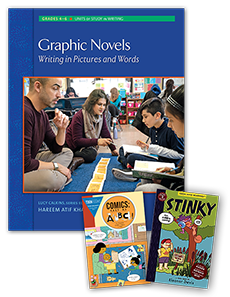
A big goal of education is to equip children with the means to compose and articulate their ideas. School, however, soon makes it clear that print is the preferred mode for such composition, with all other modes—art, theatre, music—often relegated to ‘extra-curricular’ status. Print is important, of course, and harder to learn. After all, our species has been talking, singing and drawing for far longer than we’ve been reading and writing. But even as students master the basics of reading and writing, a bigger challenge emerges. “What do I write about?” and “How do I structure, organize, craft and present my thinking?” Even more pressing: “How do I keep my reader engaged? How do I show, rather than tell?”
These are important questions, critically relevant beyond childhood and classrooms. It makes sense, therefore, for students to learn and practice with a range of tools to generate and present ideas, tools that transcend print alone. With graphic novels, print works with image, allowing a layering of information, opening endless possibilities for depicting flow and movement, pace and emotion, detail, tone, angle, perspective, framing, color… This does more than potentially engage the reader. Classroom teachers who launch a unit on graphic novel writing will vouch. This engages the writer. Kids tell us that this work is, well, fun!
But fun does not equal simple. The craft decisions involved in creating an actual graphic novel are numerous, varied, complex—but they can be explicitly taught and learned, practiced and perfected. The cognitive gains, meanwhile, are huge:
Using the Pencil as a Thinking Tool
Children pick up a pencil, and they doodle characters into “being.” At a time when computers are making pencils redundant (with some worrying that the pencil could become extinct) this helps children experience, firsthand, the power of a pencil as a thinking tool. Beyond helping with thinking and focus (as this Harvard study suggests), experimental doodling brings a playfulness and flexibility into the composition process.

Designing a Page
An essential aspect of all composition is the ordering of ideas into some sort of organizational structure. Breaking a story across pages in a book-map, and then, across panels on a page necessitates structural thinking. No longer are kids merely telling a story—they are designing a story experience.

Controlling the Reader’s Eye
The order in which speech bubbles will be read (left to right, top to bottom) means these can’t just be plopped haphazardly; the writer must plan their placement. Over and over, for every panel that the writer creates, decisions must be made: Do I zoom in to show a close-up of the character’s face or some other detail? Or do I zoom out to show the larger setting? Do I want the reader and character facing each other, or do I position the reader to see over this character’s shoulder, providing an altogether different perspective? How do I pull my reader along as we jump from one time to another time along the timeline of a story? Such decisions are made by filmmakers, photographers, animators and web designers; they push children into multiple realms of decision-making and problem-solving.
Developing Voice
If a child doesn’t learn to tell their story, then someone else will tell their story for them. Giving children permission to write with words and pictures opens a range of storytelling tools. Ultimately, each child’s artistic style is as distinct as their writing voice: quirky, versatile and unique. Comics provide tremendous resources: control, a chance to be heard, a chance to show off what they can do through art. For children who fear they aren’t ‘good at art,’ this is the time where they learn the basic iconography that can help expand their control over what they want to communicate.
Cognition is driven by emotion. When students perceive an activity as fun, they are far more receptive to instruction and content. Instead of merely reading and writing about the Algonquians, creating a graphic novel that features them requires purpose-driven inquiry into what they wore, what their homes looked like, what the landscape was: these details are essential to know in order to draw them! Creating a graphic novel to depict the Boston Tea Party necessitates similar research—to depict American and British soldiers, students will need to study primary sources to get the details of their uniforms and ammunition right.
For these reasons and more, it can be valuable to integrate art into ELA. For many children, this can make learning far more memorable!

Graphic Novels, Grades 4-6, with Trade Pack by Hareem A Khan and Eric Hand.

Hareem Atif Khan teaches in the Literacy Specialist program at Teachers College. She is also a staff developer in schools in New York City and worldwide. Before joining Teachers College and the Reading and Writing Project, Hareem was a teacher-educator and curriculum developer, beginning her career in schools in rural and urban Pakistan. She holds an Ed.M. from Teachers College and an M.Sc. in International Relations from Quaid-E-Azim University, Islamabad. Hareem has helped develop many of the Units of Study over the years, including coauthoring the Up the Ladder reading and writing series.


